Revenue Cycle Management (RCM) is gaining momentum like few things have in the dental industry in the last few years. COVID-19, inflation, and an economic slowdown have all contributed to a much higher level of understanding and focus on revenue cycle management in the Dental space.
DSOs and dental groups are realizing the importance of this function within their organizations as the primary engine for cash flow and a critical lever to deliver scale.
As they are taking a deep dive into their business, most are realizing that they are completely blind to several key performance and operational metrics within their own revenue cycle. To complicate matters, it can often be the case that a DSO maintains and operates more than one flavor of RCM support model at the same time.
At scale this becomes hard to keep track of and more groups are finding the value in specialization over generalization of tasks. When it comes to selecting the right RCM model, it does depend on the stage of growth and the nature of the support services that work best with the provider partners.
Perhaps, the right approach is a process, powered by technology and automation, that moves with a DSO over time vs. a one size fits all approach.
One RCM Model to Rule Them All
As DSOs adapt and grow, they are trying to figure out which “model” is the best to use as they structure their teams.
If you keep things In-house, then you’re opting to go through the process of hiring, maintaining staffing, education, and training. You have the ability to manage processes, but how easily can you measure the work being done by 50 employees at 50 different offices?
The limiting factor to both in-house models, centralized or decentralized, is people. Skilled RCM workers who can be efficient and effective immediately do not grow on trees. It can take anywhere from 3-6 months minimum for someone to understand all the nuances that go into submitting claims with correct codes and attachments, the best way to work aged claims, or how to expedite your posting and collections process.
The solution for some DSOs and dental groups is to Outsource some, or all of their revenue cycle, to a group that has a team of “experts”.
There are dozens of outsourced billing companies that can handle a portion of your revenue cycle, i.e., working aged claims past 90 days, or all of it from verification to posting.
While there are plenty of benefits to giving away the headache of making any of the above decisions, it will come at a cost. More importantly, can you verify their effectiveness, or track how efficiently they’re working for you?
The New “Centralized” RCM Team
Every DSO is faced with the decision of which RCM model they want to build their business on. For some groups it becomes paralysis by analysis as they try to plan long term for their growth, and the cost of pivoting from one model to another seems overwhelming.
In the end nothing gets done, nothing changes quickly, and revenue continues to be untraceable with no clear understanding of where improvements are needed.
The best solution might be a “yes” to all models. You’ve probably identified positives from each of the different RCM team structures. As a DSO continues to grow and scale, there are inherently several functions that benefit from “centralization”.
The word centralize, as described above, typically brings about a connotation of a team in the same building. While this was true just a few years ago, the age of work-from-home possibility is turning the phrase on its head.
Centralization of an RCM team moving forward means we can reimagine the possibilities and combinations. You may have the front office focus on patient intake data entry, patient balances, and claim batching, as they are closest to each of these tasks.
Then you might have a team of billers, some working in an office and others working from home, who review and submit claims, follow up and manage claims to Payers, and post payments once processed. This team may focus specifically on claims under 90 days, and their goal is to get insurance payments processed and posted quickly. This ensures that if there is any remaining patient balance, then the office has the highest likelihood of collecting.
You might utilize a third-party billing company for any Payer AR over 90 days. These claims might take longer to collect or be associated with difficult/slow Payers where it would be worth the money to let someone else handle and collect your dollars.
Ultimately you could mix and match who handles what part of the revenue cycle, but there is a place for each “model” to have an effective place in the entire process. Now the last challenge is how do you centralize a decentralized workforce?
Challenges of “Centralization” and the Necessity of Technology
While the new centralized RCM team is a compilation of multiple teams, this presents obvious challenges for tracking and managing each of the moving pieces.
The problem is that today all of the tracking is done manually via Excel, Google Sheets, and in many instances by printing and writing on AR sheets. There are too many moving pieces of data that involve separate software (20 offices on Dentrix, 8 offices on Open Dental, 4 on Eaglesoft, etc.) and reports that must be manually manipulated to figure out what’s going on.
You could move everyone to one practice management system, but now you’ve entered a potential change management nightmare. All of this manual work up front to aggregate and manipulate data means that by the time it gets to someone that can make a decision, the data might be weeks or even a month old.
Leaders can’t be expected to make effective decisions when the information they have isn’t up to date. The solution? Technology.
The new centralized team needs a platform that every team member, regardless of location, can work out of – a tool that provides accurate and transparent reporting that’s easily accessible by all.
While most dental RCM tech is just starting to get off the ground, DSOs utilizing companies like InsideDesk are seeing a 51% increase in RCM team productivity, a 34% increase in AR collection speed, and a $65,000 increase in cash flow per office. These are the measurable increases in efficiency and realized revenue that are possible with the new “centralized” RCM team.





